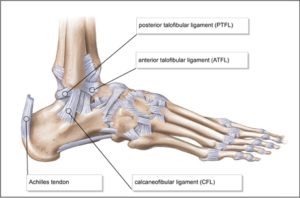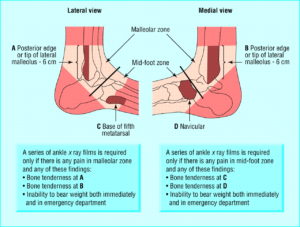What is an Ankle Sprain? What to Expect from your Athletic Trainer
You’ve heard it before. “I rolled my ankle.” But what does that mean? A ‘rolled ankle’ otherwise known as an ankle sprain is one of the most common injuries experienced while playing sports. When your child’s school ‘rolls’ or sprains their ankle, here is what to expect from the athletic trainer at your school taking care of your child’s injury.
Anatomy of an Ankle Sprain
The two most commonly injured ligaments injured in a lateral ankle sprain, the most common type of ankle injury, are the anterior talofibular (ATF) ligament and the calcaneofibular (CF) ligament. The ATF ligament connects the fibula to the talus bone, and the CF ligament, connects the calcaneus, or heel, to the fibula. Both ligaments are on the outside or lateral aspect of the ankle. The ATF and CF ligaments are most commonly injured when the foot is forcefully and excessively turned inward, past its normal healthy range of motion.

Injury Evaluation
Injury to either (or both) of these ligaments often results in pain and swelling around the injured area. After the injury occurs, the athletic trainer will evaluate the injury to assess the severity of the injury. The Ottawa Ankle Rules are a group of tests designed to rule out a potential broken bone in the ankle and/or foot. The athletic trainer will perform these tests as well as others to assess the stability of the major ligaments in the ankle. The athletic trainer will also assess for the possibility of other injuries in addition to testing the strength and available motion in the ankle. After evaluating your child’s ankle the athletic trainer may recommend your child get x-rays to further rule out the possibility of a broken bone.

Treatment and Care
Regardless of the severity of the injury, the initial treatment will be similar. Initial treatment will follow the RICE protocol. Rest, Ice, Compression and Elevation. Rest allows the ankle to heal without re-aggravation. The ice will help reduce the amount of pain your child is experiencing. The compression and elevation will help reduce and minimize the amount of swelling.
If your child is unable to bear weight the athletic trainer will provide them with crutches and/or a walking boot. During normal walking, the ankle ligaments allow motion in the foot/ankle while also providing stability to the foot and ankle. Staying off the injury allows the ligaments to heal without the repeated stresses placed on them during normal daily activities.
If your athletic trainer recommends further care, contact your PCP or local orthopedic physician. If the injury is severe your athletic trainer may recommend a referral to the nearest urgent care clinic or ER. Many times an ankle injury is not an emergency situation and does not need to seen in the ER. Follow the advise of your athletic trainer. They will recommend the best course of action for your child’s injury and help guide you through the recovery process.
Original article written by Michael Estes, MS, ATC, athletic trainer for The Center Foundation and Crook County High School in Prineville, OR.
